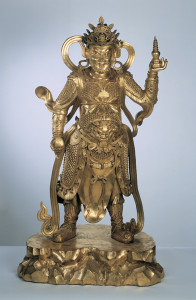The Re-display of Chinese Bronzes at Compton Verney
Look closely, the iconography is strangely familiar. The spread legs, the feet firmly planted; the passively aggressive stance that conveys infallibility, authority and awe. The gaze is challenging, an impenetrable stare that both welcomes and warns.
But this is no Holbein portrait, no Tudor tool of power and subjugation; Henry VIII plays no part in this drama, Wolf Hall seems of another world. And so we enter the room, past the two guardians, representatives of the Four Heavenly Kings or Guardians of the Four Quarters; these gilt bronze figures of impeccable Daoist pedigree. Their role today is strangely inverted, no longer is their charge to protect against evil spirits, or deter the Barbarian invasion, but now they offer a renewed challenge, and a direct one, to the visitor. “Look upon us” they seem to say, “look deeper into our craft, trace the lines, catch a glimpse in the mirror.”
Compton Verney’s Chinese collection of ancient bronzes is of international significance, and one of the three finest collections in Europe. Until last season these enigmatic bronzes were displayed in broad chronological order. It was a fascinating, stimulating, but oddly impenetrable collection; one that unwittingly hid its light under a bushel. The visitor left with curiosity renewed, but a sense of unfulfilled promise, as if the covers of the book had been glimpsed, yet the pages of the story left unread.
During the closed winter season the gallery has been working on a major re-display of the Chinese collection, and visitors in March 2015 will have the opportunity to re-discover these stunning artefacts. Great care and attention has been given to both the physical and contextual display of items. The palette upon which they are displayed is a joy; gone is the slightly garish yellow hue, replaced by a warm grey, imbued with a depth of suggested colours. Against this the new display cabinets have been designed for both accessibility (visibility is greatly improved for both children and wheelchair users), and for greater engagement. The innovative positioning of objects, and their greatly improved state-of-the-art lighting, enables new ways of seeing. Colour and detail, once seemingly missing amongst this “sea of green vessels”, is now startlingly present, and brings a new vibrancy and vitality to the pieces. In some cases under-lighting adds a refreshing new dimension to familiar objects.
But the most welcome change, and the most positive step towards improved engagement and understanding, is the adoption of thematic displays and greatly enhanced labelling. We no longer tread a timeline of seemingly unrelated artefacts, but inhabit a world of food and drink, ritual and symbolism, horses, mirrors, and strange mythical beasts. Through this narrative we come to understand a people, distant both in terms of geography and time, though strangely familiar to us through their shared human frailties, their superstitions, beliefs and traditions.
The re-display also makes great leaps towards greater accessibility and engagement for the young. As the National Curriculum now embraces the history of China amongst its various options, this collection provides a vibrant and stimulating learning opportunity for younger visitors. What child can resist the allure of dragons, monsters, and the mythical taotie? Indeed, who can resist staring into a polished bronze disc and dreaming of what might have been? In the adjoining learning rooms we can also see the influence of ancient Chinese culture upon later generations, through the media of 20th century posters. What better way than through such early engagement, for younger visitors to reach an understanding of our diverse cultures, and shared humanity?
Just as importantly, objects in the collection are de-coded for the first time, and we start to understand what our eyes previously just saw. We begin to comprehend the significance of ritual objects in the honouring and remembering of the dead, and of their place in both the afterlife and the here-and-now. Above all, we start to see the people behind the objects in a way that’s not been possible before. The collection holds out a hand to us, and craves our understanding. The tension between symbolism and utility is slowly resolved in our minds.
And so, as my time to leave these rooms comes, I return once more to the display of mirrors. One in particular holds my attention, and draws me closer. “Mirror with coiled dragon. Bronze, Tang dynasty (AD 618-906)” the caption informs me. The sinuous dragon, a potent symbol of the Emperor himself, writhes amongst floating clouds, and as I look at him I imagine the polished bronze reverse, the burnished disc into which distant eyes once stared. I picture the owner looking back at me, his or her face softly illuminated in the reflected glow. And it seems to me that we stand beyond their gaze, the other side of the mirror, and yet in some way it’s we who are the reflection, we who shine back to them across time, living embodiment of what would become. A continuum of humanity, linked across time by shared experience and imagination; brothers and sisters, each interpreting a bewildering world, finding our way, telling our tales. And through these bronzes those tales are passed on, and on.
Notes
I’m grateful to Annelise Hone and Morgan Jones of Compton Verney for the opportunity to witness the re-construction of the galleries in progress, and for an insight into the re-interpretation of the Chinese Bronzes collection.
All images are courtesy and copyright of Compton Verney.



